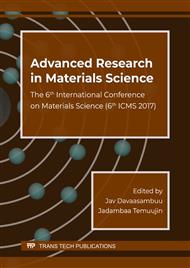p.76
p.85
p.92
p.98
p.106
p.112
p.119
p.124
p.133
Influence of the Active Layer Thickness on Non-Fullerene Polymer Solar Cell Performance
Abstract:
Research on polymer solar cells has attracted increasing attention in the past few decades due to the advantages such as low cost of fabrication, ease of processing, mechanical flexibility, etc. In recent years, non-fullerene polymer solar cells are extensively studied, because of the reduced voltage losses, and the tunability of absorption spectra and molecular energy level of non-fullerene acceptors. In this work, polymer solar cells based on conjugated polymer (PBDB-T: poly [(2,6-(4,8-bis (5-(2-ethylhexyl) thiophen-2-yl)-benzo [1,2-b:4,5-b’] dithiophene))-alt-(5,5-(1’,3’-di-2-thienyl-5’,7’-bis (2-ethylhexyl) benzo [1’,2’-c:4’,5’-c’] dithiophene-4,8-dione))]) and non-fullerene electron acceptor (ITIC: 3,9-bis (2-methylene-(3-(1,1-dicyanomethylene)-indanone)) -5,5,11,11-tetrakis (4-hexylphenyl)-dithieno [2,3-d:2’,3’-d’]-s-indaceno [1,2-b:5,6-b’] dithiophene) were prepared by means of spin-coating method, and the influence of the active layer thickness on the device performance was investigated. PBDB-T: ITIC active layers with different thickness were prepared through varying spin coating speed. It was found that the solar cell performance is best when the active layer thickness is 100 nm, corresponding to the spin coating speed of 2000 rpm. Maximum power conversion efficiency of 7.25% with fill factor of 65%, open circuit voltage of 0.85 V and short circuit current density of 13.02 Am/cm2 was obtained.
Info:
Periodical:
Pages:
106-111
Citation:
Online since:
January 2018
Authors:
Keywords:
Price:
Сopyright:
© 2018 Trans Tech Publications Ltd. All Rights Reserved
Share:
Citation:


